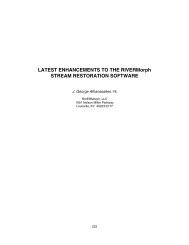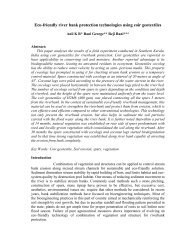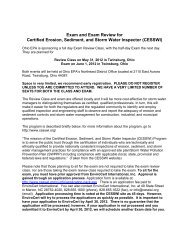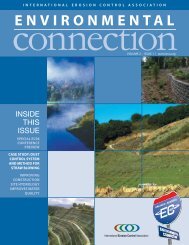ENVIRONMENTAL - International Erosion Control Association
ENVIRONMENTAL - International Erosion Control Association
ENVIRONMENTAL - International Erosion Control Association
You also want an ePaper? Increase the reach of your titles
YUMPU automatically turns print PDFs into web optimized ePapers that Google loves.
Ancient Malindi Coral Reef<br />
Tells Story of Soil <strong>Erosion</strong> in Kenya<br />
By Maria José Viñas<br />
Reprinted with permission from the Stanford Report, April 11, 2007.<br />
http://news.stanford.edu<br />
Coral reefs, like tree rings, are natural<br />
archives of climate change.<br />
But oceanic corals also provide<br />
a faithful account of how people make<br />
use of land through history, says Robert<br />
B. Dunbar of Stanford University.<br />
In a study published in the Feb. 22<br />
issue of Geophysical Research Letters,<br />
Dunbar and his colleagues used coral<br />
samples from the Indian Ocean to create<br />
a 300-year record of soil erosion in<br />
Kenya, the longest land-use archive ever<br />
obtained in corals. A chemical analysis<br />
of the corals revealed that Kenya has<br />
been losing valuable topsoil since the<br />
early 1900s, when British settlers began<br />
farming the region.<br />
“We found that soil erosion in Kenya<br />
increased dramatically after World War I,<br />
coinciding with British colonialism and a<br />
series of large-scale agricultural experiments<br />
that provoked a dramatic change in human<br />
use of the landscape,” said Dunbar, a professor<br />
of geological and environmental sciences.<br />
“Today, the Kenyan landscape continues<br />
to lose topsoil to the Indian Ocean,<br />
primarily because of human pressure.”<br />
<strong>Erosion</strong> is a serious threat, he noted,<br />
because the loss of fertile soil often is<br />
accompanied by a decrease in food production.<br />
According to one recent study,<br />
soil erosion is a global problem that has<br />
caused widespread damage to agriculture<br />
and animal husbandry, placing<br />
about 2.6 billion people at risk of famine.<br />
“This is particularly worrisome in<br />
East and sub-Saharan Africa, where per<br />
capita food production has declined for<br />
the last half-century,” Dunbar said.<br />
Coral Bands<br />
For the study, Dunbar and his colleagues<br />
donned scuba gear and dove to<br />
the Malindi coral reef near the mouth<br />
of the Sabaki River, the second longest<br />
river in Kenya. Draining about 11 percent<br />
of Kenya’s landmass, the Sabaki<br />
transports sediments to the sea.<br />
The researchers took core samples<br />
from two large coral colonies, each more<br />
than 12 feet tall and about 15 feet wide.<br />
To find out how sediment flux has varied<br />
over the years, Dunbar’s team measured<br />
the ratio of two elements—barium and<br />
calcium—in the coral skeleton, which<br />
is composed of calcium carbonate. “It<br />
turns out that there is a lot of barium in<br />
soils,” Dunbar said. “So whenever something<br />
changes the landscape and causes<br />
the soil to erode and wash into the rivers,<br />
the soil is delivered to the sea. And<br />
with that soil comes the barium.”<br />
The corals then incorporate the barium<br />
in well-developed bands that pro-<br />
vide a record of annual growth, similar<br />
to tree rings, he added. To measure barium<br />
levels in the corals, Dunbar’s team<br />
applied an innovative technique that<br />
quickly vaporizes the carbonate, then<br />
analyzes its chemical composition with<br />
a mass spectrometer.<br />
“In the past we used a dentist drill,”<br />
Dunbar said. “We drilled out a little bit<br />
of powder, and then we dissolved the<br />
powder and took it to the lab, where<br />
we measured the barium with a wet<br />
chemical technique. It was a very slow<br />
process, very painful. It took forever to<br />
get data.” The new method, developed<br />
by researchers at the Australian National<br />
University, “increased the speed at<br />
which we could collect data by a factor<br />
of 50,” he noted.<br />
Equilibrium Loss<br />
An analysis of barium levels revealed<br />
that prior to about 1915, the Kenyan<br />
landscape was in equilibrium—rain<br />
washed out some soils moderately from<br />
decade to decade in a regular cycle that<br />
was only altered by periods of drought.<br />
“But in the late 1910s, the amount of<br />
barium coming down to the coast suddenly<br />
shoots up, and it keeps rising and<br />
rising,” Dunbar said. “This represents<br />
colonial land change, when the British<br />
16 • <strong>ENVIRONMENTAL</strong> CONNECTION













